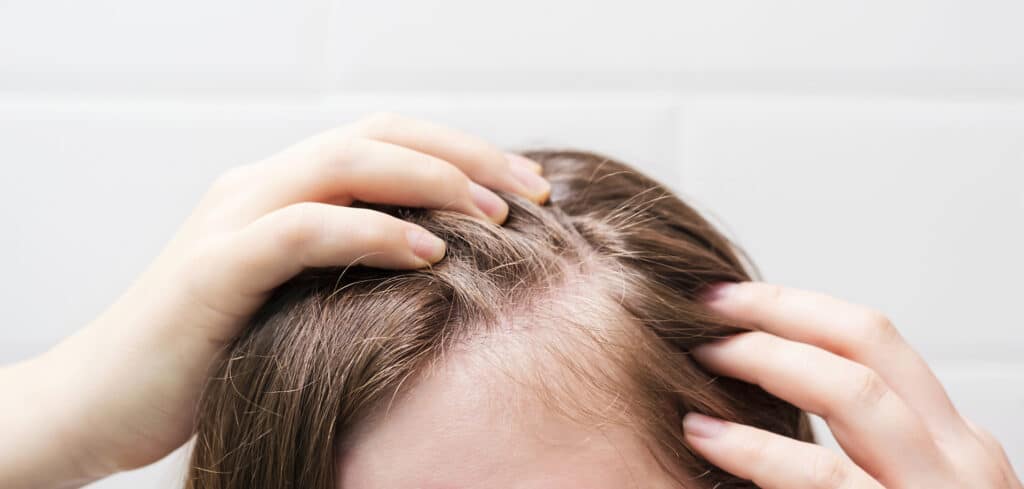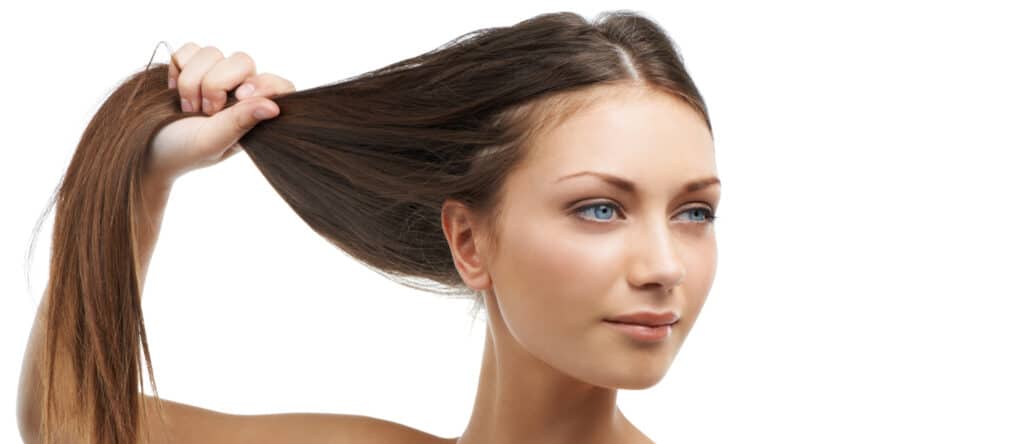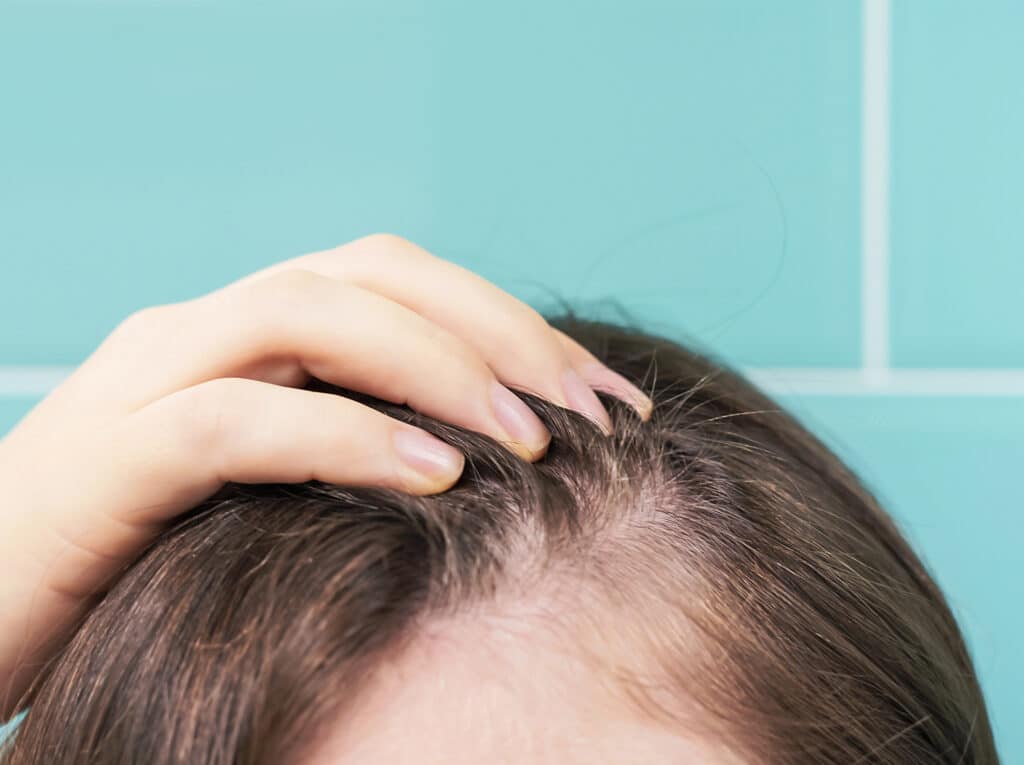Women’s hair thinning at temples is a reality for many women. But, it’s not easy and can be depressing. Many women shun social life because of it. But is it the end? Not at all!
Let’s see more about hair thinning at temples and how to manage it naturally and if or not something can be done about it. Shall we?
What’s Hair Thinning at Temples?
First, let’s talk about temples. Temples are the area or latch where four bones of our skull meet. Temples are located on both sides of our head, behind the eye but between our forehead and the ear.
When there’s thinning, it’s not just the hair part that it happens. Temples can fall prey to it too! When there is a reduction in volume or receding hairline around one’s temples, it’s referred as thinning of hair at temples.

Causes of Thinning at Temples
Understanding the causes behind thinning hair around one’s temples can make it easier to manage it.
Genetics
Genetics has a significant role to play in hair loss, just like several other aspects in one’s life. Did you know female pattern baldness and male pattern baldness are both due to one’s genetics?
Female pattern hair loss or androgenetic alopecia as it’s often called is one of the leading causes for thinning hair in women. Though it’s not the only cause, it’s still one of the major causes. Millions of women suffer from hair loss due to androgenetic alopecia annually. So, it’s only men that face male pattern hair loss!
Health Conditions or Treatments
Certain medical treatments or medical conditions can contribute to hair loss at the temples. PCOS, thyroid, chemotherapy and radiation therapies are few examples for this. At times, even a shock can push us into excessive stress and trigger hair loss resulting in thinning. Even deficiencies of key nutrients can cause excessive hair loss leading to thinning hair.
Alopecia Areata
Did you know there are many different types of alopecia areata? It’s no wonder it’s one of the leading causes of hair loss or hair thinning!
Involutional alopecia is when more hair follicles go into the resting stage as part of the aging process. Then there’s another called traction alopecia where one hair follicle is damaged. We have already discussed androgenic alopecia.
There’s something called scarring alopecia that destroys hair follicles. Then there’s frontal fibrosing alopecia that destroys hair follicles leaving one with permanent hair loss. Did you know it looks like a receding hairline that often affects one’s front and sides of the head? Did you know frontal fibrosing alopecia could be the reason behind one’s hair loss at the temples?
Hormonal Imbalances
Can we forget about hormonal imbalances? In particular, an excess of hormones called androgens is a significant contributing factor for thinning and hair loss. In fact, PCOS (polycystic ovary syndrome) is often due to hormonal imbalance.
Stress
Let’s not forget about stress! Both physical or emotional stress can trigger the problem. That’s why it’s one of the major contributing factors not just for hair loss, but for several health issues or otherwise in our lives!
But stress has become a part and parcel of our lives due to the hustle and bustle of modernity! Isn’t it? This is why hair loss treatment often starts with dealing with stress!
Did you know stress not only causes hair shedding, can damage hair follicles and even hair growth cycle? Stress could be either physical or emotional and can also slow down hair growth!
Styling & Hair Care
Hair Care Practices are often the unsuspected or forgotten element in the hair loss story! Today, styling has become very common and no longer raises eyebrows. Even kids do it to some extent. What gives?
Heat or chemical treatments and even certain chemical-laden hair care products and don’t forget the tight or pulled up hairstyles. All these contribute to thinning and more! Even improper hair care could be a cause! Ever thought about it?
Symptoms to Look Out For
Some telltale symptoms help identify the issue in a timely manner. There are times when early intervention can help and often keep pushing temporary hair loss into permanent hair loss! Though there can be other symptoms, we’re looking at the most common symptoms to look out for!
Visible Scalp
A telltale symptom to look out for – visible scalp area. This will be in stark contrast to the surrounding areas, especially initially, making it easier to identify if you know what to look for!
Receding Hairline
Not just for androgenetic alopecia, receding hairline is common with thinning of hair or excessive hair fall. It can even happen due to other reasons including traction alopecia. This is another telltale sign to look out for.
Thinning
We’re talking about thinning at one’s temples, so this goes without saying. Temple hair loss that results in thinning at temples could be due to increased hair shedding that’s not just limited to one’s temples or just a loss of hair density. So, there could be a diffuse thinning that’s not just restricted to the temples, but there you have it! It’s another sign you need to watch out for!
Hair Loss
Thinning and hair loss can go hand in hand, though not necessarily. Your hair could look like it just transitioned to fine hair from thicker hair due to thinning, or you might have lost hair in the process. Understanding whether temple hair loss is due to overall hair loss helps. So, look out for that.
Remedies & Remedial Measures
In today’s fast-paced world everything has become revolutionized and there are very few people who can adopt a completely natural lifestyle, especially when living in the cities. But there are remedies and remedial measures that we can take – every little change goes a long way. So, let’s start somewhere! Let’s take a look at a few.

Alternative or Holistic Lifestyle
Many opt for holistic hair treatments for treating hair loss these days. There’s increased awareness about alternative medicine and its contribution to our health, not just to prevent female hair loss!
With more interest in these methods, more specialists are raising awareness on the dos and don’ts to stimulate hair growth, hair regrowth, prevent hair loss in women and men, grow healthy hair and keep one’s scalp problem-free.
Adopting a lifestyle that’s closer to our roots really helps avert a lot of issues, not just hair loss in women or temporal hair loss. Walking with bare feet, also called grounding, can do wonders for one’s body and to relieve stress.
Herbal Remedies
There are many herbal remedies one can consider when dealing with gradual thinning, hair loss and more. Did you know even emotional stress or other issues that can trigger hair issues or otherwise can be dealt with herbal remedies?
We have already covered Saw Palmetto, Ginseng, etc. Let’s take a look at a few that help with temple hair loss.
A herb known for its anti-ageing properties, it’s also used to prevent premature graying. Besides, it’s also used to promote hair growth and improve hair health. It’s widely used in Chinese Medicine for health and hair benefits.
Burdock Root
This root is believed to strengthen hair follicles and improve scalp circulation. It also keeps the scalp healthy and offers a conducive environment for hair growth and vitality.
Sage
Rich in anti-inflammatory properties and antioxidants, sage can stimulate hair growth and improve scalp health. Did you know inflammation can damage your hair follicles irreparably?
Another sweet root that has been used in Ayurveda and other traditional medicine methods to combat dandruff and hair loss. It can also strengthen hair follicles and soothe an irritated scalp.
How to Use These Herbs?
You can brew them as tea, use their essential oils where available to apply topically, add their powders or extracts to your hair mask or even prepare herb-infused oils with them. Did you know some can be taken as supplements? So, take your pick!
Hydration
Did you know water is very essential for our hair health? Yes, without proper hydration your locks and scalp can turn dry. Dry scalp and hair can lead to scores of issues including hair breakage and frizz. So keep hair and health issues at bay by keeping yourself hydrated at all times.
Hair & Scalp Care
Needless to say, how we care for our hair and scalp will not only prevent or help manage female temple hair loss, it can keep scores of hair or scalp issues at bay.
By taking care while styling one can prevent traction alopecia – say no to tight braids, excessive styling or heat treatments. They can potentially damage hair and more.
Don’t take note of an issue only when you realize you’re missing hair and a lot of it. Spend time with yourself! Give your hair the time and TLC that it deserves!
Want to treat hair loss? It starts with caring for your hair and scalp right and avoiding or keeping styling to bare minimum! Say no to harsh heat or chemical treatments, coloring, etc. Even harsh chemicals in styling or hair care products can trigger female hair loss!
Temple hair loss might have its roots elsewhere. Try and identify what’s causing it and address it. Get professional help if you’re not able to do it on your own. Female hair loss can be depressing and many women come into Vitamins Revive and have seen good improvement. Professionals are there for a reason – ask or seek help!
Diet & Nutrition
Diet and nutrition are the cornerstones of our health. It’s important to consume a healthy and balanced diet to keep ourselves nourished.
Did you know deficiencies are more common in female hair loss? Iron deficiency is the leading cause, though Vitamin D comes close behind! Many women only have to figure out what their deficiencies are to treat hair loss! It’s that common in some countries.
Healthy Lifestyle
Healthy lifestyle can do wonders for one’s mind and body. Even alopecia areata is often due to stress – a lifestyle change to manage stress can help.
An active lifestyle is also important to stay healthy and happy. Did you know exercising regularly keeps stress at bay? Get moving today, not just for your locks, but also for your health!
Treatment Options
There may be times when hair loss or receding of one’s hairline becomes permanent. It could have started off temporarily but missing signs could have made it permanent. Or some issues don’t respond to your efforts. Irrespective of what happened and how, there are options that one can consider.
There are certain medications like finasteride and minoxidil that are used to combat hair loss and stunted hair growth in women.
Hair transplants are gaining ground as a way to restore one’s looks and improve volume.
Platelet rich plasma injections or therapy is another option for improving hair growth.
Low level laser therapy also called as red light therapy is another for women and has been a ray of hope in many.
Coping With Hair Loss
Hair loss can affect one psychologically and emotionally. Female pattern baldness isn’t the only condition that can do that. Women are sensitive and anything that takes a toll on their emotional well-being should be addressed.
Accept the reality of hair loss or thinning. That’s the first step. You can also consider counseling or community support groups. It’s not a shame to do that. You’re worth it – do what it takes to keep yourself healthy and happy!
Conclusion
Whether it’s losing temple hair or androgenetic alopecia, understanding what’s causing it can go a long way in managing the issue. Male hair loss or hair loss in women, it can take a toll on one’s confidence and self-esteem.
We have always suggested going the natural route for any issue. Do give these natural remedies or methods a try. They’re natural and effective and in most cases, helped a lot of women. Getting timely help and taking remedial measures can help reverse or combat the problem. What’s your say? Did you try any remedies and how did they work out for you?

